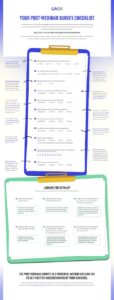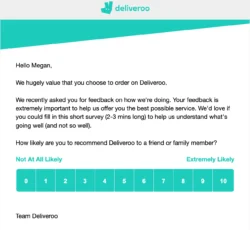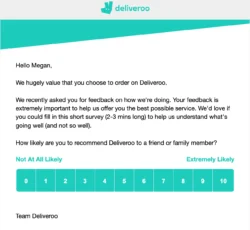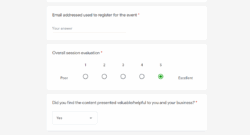It happens to the best of us: you plan an incredible webinar, you promote it, people register, and then… a significant portion don’t show up. It’s a common challenge in the world of online events, and while it’s easy to get frustrated by those no-shows, what if you could turn that missed opportunity into valuable insight? Instead of just accepting it, imagine understanding why people didn’t attend and using that information to make your next webinar even more successful.
Understanding the reasons behind non-attendance isn’t about shaming anyone; it’s about continuous improvement. Whether it’s a scheduling conflict, a forgotten reminder, or something else entirely, gathering feedback from those who registered but didn’t join can provide critical data points. This data can inform your future webinar topics, promotional strategies, reminder sequences, and even your ideal timing, helping you boost attendance and engagement for subsequent events.
Why Bother Surveying Those Who Didn’t Show Up?
You might be thinking, “They didn’t even show, why should I spend more time on them?” And that’s a fair initial thought. However, dismissing non-attendees means missing out on a treasure trove of actionable feedback. These individuals expressed initial interest by registering, which means they were at least somewhat engaged with your topic or brand. Their reasons for not showing up are often logistical or related to perceived value, rather than a complete lack of interest. Tapping into this audience helps you refine your entire webinar strategy, from promotion to post-event follow-up.
Consider the various factors that could prevent someone from attending. Was the time slot inconvenient? Did they simply forget? Was the reminder email perhaps not compelling enough, or did it get lost in their inbox? Perhaps they signed up for multiple webinars and had to prioritize another, or maybe the title didn’t quite match their expectations once the day arrived. Without asking, these remain mysteries, leaving you to guess and potentially repeat the same pitfalls.
By proactively reaching out with a simple, respectful survey, you demonstrate that you value their time and input, even if they couldn’t make it. This gesture can actually strengthen your relationship with them, fostering goodwill and making them more likely to consider attending your next event. It shows you’re committed to delivering value and improving your offerings based on audience needs, which is a powerful message for brand building and customer loyalty.
Ultimately, surveying non-attendees is a strategic move to optimize your future events. It moves you beyond anecdotal evidence and into data-driven decision-making. The insights gained can be directly applied to improve registration-to-attendance rates, ensuring your efforts lead to more engaged participants and a higher return on your webinar investment.
Key Areas to Explore in Your Survey
When crafting your survey, focus on gentle, non-intrusive questions that are easy to answer. You’re seeking constructive criticism, not an inquisition. Here are some key areas to touch upon:
- Scheduling Conflicts: Was the time or day inconvenient? What would be a better time for them?
- Reminder Effectiveness: Did they receive the reminders? Were they helpful? Too many or too few?
- Technical Issues: Did they attempt to join but face technical difficulties? (e.g., audio, platform access)
- Topic Relevance: Did the topic remain as interesting as they initially thought? (Subtle way to gauge initial interest vs. perceived value on the day)
- Unexpected Commitments: A simple open-ended question about what came up.
- Future Interests: What other topics would they be interested in for future webinars?
Designing Your Survey Template for Webinar Non-Attendees
Crafting an effective survey for webinar non-attendees requires a delicate balance of brevity, respect, and actionable questioning. Remember, these individuals already didn’t commit their time to the webinar, so a long, demanding survey will likely be ignored. Aim for a quick, polite outreach that respects their inbox and time, making it as easy as possible for them to provide feedback with minimal effort. This approach ensures a higher completion rate and more useful data.
Start with a clear, concise subject line for your email, something like “Quick Question About Our Recent Webinar” or “Your Feedback on Our Webinar.” In the email body, acknowledge that they registered but weren’t able to make it, and assure them that their input is valuable for improving future events. Emphasize that the survey will only take a minute or two of their time. This upfront honesty sets the right expectation and encourages participation.
When designing the actual survey questions, lean heavily on multiple-choice options where possible. This makes it incredibly fast for respondents to click through. For instance, instead of asking “Why didn’t you attend?” (which could lead to a blank text box), provide options like “I had a scheduling conflict,” “I forgot about it,” “Something unexpected came up,” or “Technical issues.” Always include an “Other (please specify)” option for those unique situations.
While multiple-choice questions are great for quantitative data, sprinkle in one or two optional open-ended questions for qualitative insights. These could be “Is there anything specific we could do to make it easier for you to attend next time?” or “What other topics would you be interested in?” Keep these optional to maintain a low barrier to completion. By carefully designing your survey template for webinar non-attendees, you transform missed connections into a powerful tool for growth and improved engagement for your next online event.
By systematically collecting and analyzing this feedback, you gain a clearer picture of potential barriers and preferences within your audience. This data empowers you to fine-tune your webinar marketing, scheduling, and content strategies. You might discover that a different time zone would capture more attendees, or that more frequent, varied reminders are necessary.
Leveraging the insights gleaned from your post-webinar survey for non-attendees is a pivotal step in refining your event strategy. It helps you move beyond assumptions and make data-driven decisions that can significantly improve your registration-to-attendance conversion rates and overall audience satisfaction. Each piece of feedback, even from those who didn’t show, contributes to building a more robust and effective webinar program.



